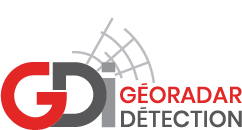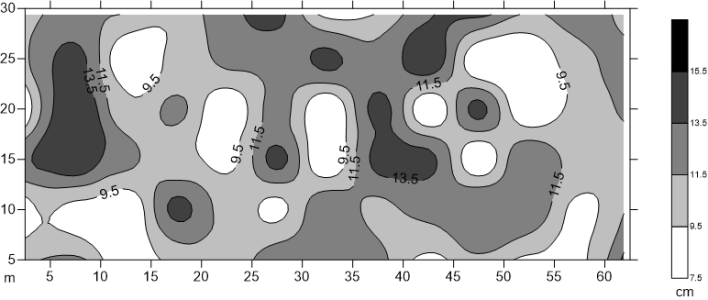Floor slab scanning - slab thickness mapping
In some places, in a factory specializing in the manufacture of huge metal parts, the thinness of the slabs on the ground put the safety of workers and equipment at risk.
Indeed, in some places, the slab gave way under the weight of the metal parts when they were placed on work benches on legs.
In order to know the thickness of the slabs in the different parts of the factory, the officials called on a firm to verify the thickness of the slabs by coring in a few places. With this method, no useful conclusion could be possible since the thickness distribution seemed to be rather random and it was not possible to target in which parts of the plant the slabs were too thin to support heavy loads. Many more cores would have been necessary.
The GDI GÉORADAR-DETECTION method
In order to map the thicknesses of the slabs in more details, our client called on our services and the proposed method was implemented.
In the problematic 25,000 square foot area of the plant, 50 locations were surveyed with a GPR following a pre-established sampling grid.
With adequate post-processing, the contour map to scale (shown at top) was then produced from a table of the data collected.
Advantage of the GPR method vs coring
● Much greater number of samples in less time
● A GPR reading takes a few seconds compared to coring which can take several minutes (up to 1 hour). At each location, the plant personnel suffer much less inconvenience with the GPR method.
● No safety problems due to holes temporarily left after coring
● No safety concerns caused by the electrical extension cords required for a core drill and a vacuum cleaner
● No problem with circuit breakers that often blow due to the amperage required by a core drilling machine
● No hole to plug
In some places, in a factory specializing in the manufacture of huge metal parts, the thinness of the slabs on the ground put the safety of workers and equipment at risk.
Indeed, in some places, the slab gave way under the weight of the metal parts when they were placed on work benches on legs.
In order to know the thickness of the slabs in the different parts of the factory, the officials called on a firm to verify the thickness of the slabs by coring in a few places. With this method, no useful conclusion could be possible since the thickness distribution seemed to be rather random and it was not possible to target in which parts of the plant the slabs were too thin to support heavy loads. Many more cores would have been necessary.
The GDI GÉORADAR-DETECTION method
In order to map the thicknesses of the slabs in more details, our client called on our services and the proposed method was implemented.
In the problematic 25,000 square foot area of the plant, 50 locations were surveyed with a GPR following a pre-established sampling grid.
With adequate post-processing, the contour map to scale (shown at top) was then produced from a table of the data collected.
Advantage of the GPR method vs coring
● Much greater number of samples in less time
● A GPR reading takes a few seconds compared to coring which can take several minutes (up to 1 hour). At each location, the plant personnel suffer much less inconvenience with the GPR method.
● No safety problems due to holes temporarily left after coring
● No safety concerns caused by the electrical extension cords required for a core drill and a vacuum cleaner
● No problem with circuit breakers that often blow due to the amperage required by a core drilling machine
● No hole to plug

